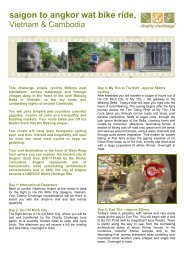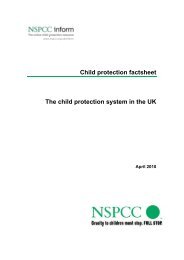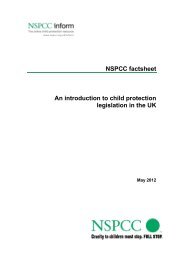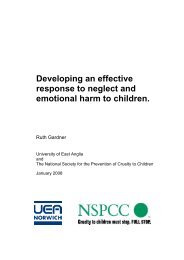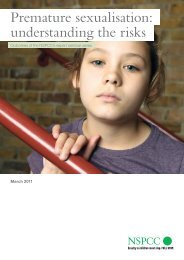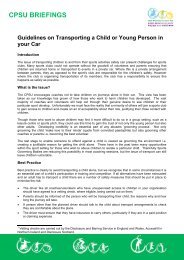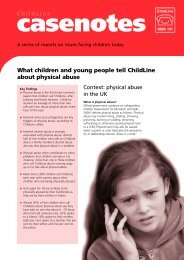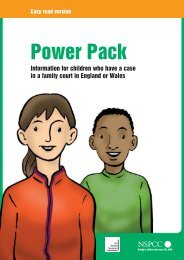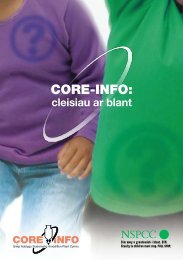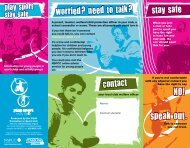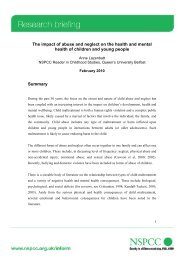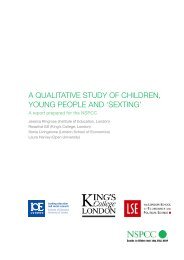Neglect and serious case reviews (PDF, 735KB) - nspcc
Neglect and serious case reviews (PDF, 735KB) - nspcc
Neglect and serious case reviews (PDF, 735KB) - nspcc
Create successful ePaper yourself
Turn your PDF publications into a flip-book with our unique Google optimized e-Paper software.
learning:<br />
themeS aNd learNiNg poiNtS<br />
Not taking account of a history of violence<br />
hostility to professionals<br />
3. A thematic analysis of neglect<br />
This <strong>case</strong> highlights the problems of gaining a full underst<strong>and</strong>ing of a <strong>case</strong><br />
when the family moves around regularly <strong>and</strong> their history is unknown, or<br />
only partially known. However it also shows that when new information<br />
becomes available professionals are reluctant to reappraise the <strong>case</strong> <strong>and</strong><br />
change their view. It shows how powerful the label of ‘low level neglect’<br />
can be <strong>and</strong> the way that it can downgrade thinking <strong>and</strong> activity. The<br />
combination of a mindset about low level neglect <strong>and</strong> parental hostility<br />
kept professionals at bay.<br />
In a number of these <strong>case</strong>s the past history represented very <strong>serious</strong> risks of harm to the<br />
child but was not present in the minds of the professionals. This history was sometimes<br />
not taken <strong>serious</strong>ly because professionals had decided that the key risk of harm to the<br />
child was neglect or emotional maltreatment <strong>and</strong> so the risk of violence was effectively<br />
discounted. Evidence of <strong>serious</strong> past physical abuse from a parent included: putting a<br />
pillow over a child’s face, previous unexplained child death, a history of a previous child<br />
being adopted because of a prosecution for assault by a parent, <strong>and</strong> very <strong>serious</strong> offences<br />
of parental violence, including offences against children.<br />
These <strong>case</strong>s of combined physical abuse <strong>and</strong> neglect often included parental violence<br />
<strong>and</strong> hostility towards professionals as well as extreme distrust of workers. In most instances<br />
the hostility <strong>and</strong> violence was perpetrated by the father or male figure, but in<br />
other <strong>case</strong>s, as in the <strong>case</strong> vignette, it was the mother who posed the greater risk of<br />
violence to the baby or child <strong>and</strong> was the most hostile part of the couple. Sometimes<br />
both parents were hostile but in most of these <strong>case</strong>s there was one especially controlling<br />
partner who tended to dictate the terms of the relationship with professionals. Any<br />
services were usually only accepted on the controlling parent’s terms, with considerable<br />
reluctance <strong>and</strong> following much negotiation. In some <strong>case</strong>s parents insisted on following<br />
their own idiosyncratic beliefs about how to meet children’s health <strong>and</strong> dietary needs as<br />
well as refusing immunisations <strong>and</strong> medical treatments. Professional concern about the<br />
family tended to dissipate however if the less hostile parent appeared to cooperate, even<br />
if there was no cooperation from the more hostile parent.<br />
Our first two biennial <strong>reviews</strong> noted that the level of cooperation or hostility between<br />
families <strong>and</strong> agencies had an impact on the way that practitioners understood the families<br />
<strong>and</strong> the risks of harm to the child (Br<strong>and</strong>on et al 2008, 2009). In the <strong>case</strong>s here there<br />
was a reluctance to challenge hostile parents who appeared to induce fear, paralysis <strong>and</strong><br />
67



